Summer of Love Experiments: Perceptual Expansion
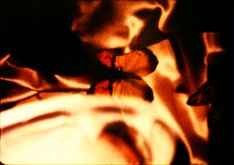
Third Eye Butterfly By Storm De Hirsch
Sunday July 16, 2017, 7:30 pm
Los Angeles Filmforum presents
Summer of Love Experiments: Perceptual Expansion
At the Spielberg Theatre at the Egyptian, 6712 Hollywood Blvd., Los Angeles CA 90028
Sam Erenberg in person (schedule permitting)!
The Summer of Love. We commemorate the 50th anniversary of the radical cultural upheaval with an assortment of mind-blowing (as intended) short underground films. These films used a variety of tactics to manifest or assist with perceptual expansion and experience found in sex, drugs, music, and art. Some pursue idea of psychedelia (Third Eye Butterfly; Doppler Effect: Version II) others express openness in sexuality (Fuses); and others try to capture some of the spirit of group revelry, drug-taking and celebration (Letter to D.H. in Paris; Be-In: 1967). Albert Alotta’s Peacemeal captures one of the war protests, the essential underpinning of the events of the year. Les Blank’s God Respects Us When We Work But He Loves Us When We Dance and Sam Erenberg’s Elysian Park II were both filmed at the same event, the Easter Sunday Love-In in Los Angeles’s Elysian Park in 1967, but take radically different approaches to making sense of joyful events of the day. Apropos of San Francisco and Malanga dive into the possibilities of film form and structure, using repetitions, filters, and other strategies, while other filmmakers those as part of a way to find a cinematic correlate to revelry and drug states. Overall, the films find the spirit of the year and some of its dark undertow. (Some adult content; plan accordingly.)
Tickets: $10 general admission; $6 students (with ID)/seniors; free for Filmforum members.
Tickets available at http://bpt.me/3040934 or at the door
For more event information: www.lafilmforum.org, or 323-377-7238

Be-In: 1967
Be-In: 1967
By Jerry Abrams (1967, 16mm, color, 7 min.)
Music by Blue Cheer. Captures the spirit and essence of the great San Francisco Human Be-In of January 14, 1967. Ten thousand people imbued with peace, love and euphoria. Set to hard rock such as only San Francisco blues can produce. BE-IN contains Allen Ginsberg, Lawrence Ferlinghetti, Timothy Leary, Michael McClure, Lenore Kandel and Buddha.
Apropos of San Francisco
By Charles I. Levine and Ben Van Meter (1968, 16mm, 4.5 min.)
(After or for Jean Vigo). A study in visual rhythms and structure, using the same basic element repeated with variations.
“In Apropos of San Francisco (1968), Charles Levine fabricates a spirited emblem of hippie culture by transforming a brief shot of filmmaker Ben Van Meter into a five-minute looped dance with occasional variations.” – Paul Arthur, A Line of Sight: American Avant-garde Film Since 1965.
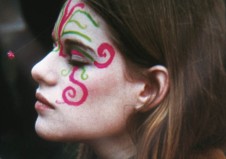
Peacemeal
Peacemeal
By Albert Alotta (1967, 16mm, color, 7.5 min.)
Hippies, peace-niks, students, beautiful girls, civil righters, old ladies and more, protest the war. Who dares to say that they don't influence the mainstream? Beautiful color and exciting montage capture the feeling and motion of the march on the United Nations.
Malanga
By A. Keewatin Dewdney (1967, 16mm, b&w, 3 min.)
Gerard Malanga reads his poetry for 24 frames, dances to Velvet Underground for 24 frames, reads for 23 frames, dances for 23 frames, reads for 22 frames, etc., until he is doing both things alternately one frame at a time. An experiment in Audio-visual synaesthesia called Discontinuous film. No frame is missed however brief its exposure because the synthaesthesia increases efficiency of both eye and ear. --K. D.
Letter to D.H. In Paris
By David Brooks (1967 16mm, color, 4 min.)
Stoned people, music, movement, fields.
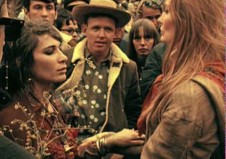
God Respects Us When We Work But He Loves Us When We Dance
God Respects Us When We Work But He Loves Us When We Dance
By Les Blank (1968, 16mm, color, 20 min.)
An original rock music score accentuates this film panorama of the action and more meditative moments occurring at Los Angeles' memorable 1967 Easter Sunday Love-in. Earmarks of the alternative culture, like open use of drugs, meditation, free expression of love and affection are revealed in this colorful and candid record of a social phenomenon.
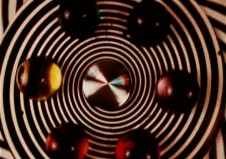
Doppler Effect: Version II
Doppler Effect: Version II
By Dan Agnew (1968, 16mm, b&w, 4.75 min.)
DOPPLER EFFECT began as a severe condensation of my own stock footage in 1967. Version I (12 min.) is unprintable, due to the wide variation of film stocks and sound levels. The original sound track was composed by Duane Hitchings in the Fall of 1967 on the Moog Synthesizer at Pennsylvania Musical Academy. Doppler is basically (a+b+c) with variations and a time interval of 30-1/8 sec. This expansion breaks into a, b, c combinations with arbitrary yet consistent designation. Also you may note the abstract visuals are match-cut so that they appear to move in continuous kinetic flow. This technique has been fully developed in DOPPLER EFFECT, Version III, my completed match to the chorus of 'Hey, Jude.' (Unfortunately, the verses are matched to original 8mm, which makes projection a bit difficult). It is a subjective thought piece which really does not lend itself to any description, other than the fact it works damn well when one is stoned. Also see http://thesoundofeye.blogspot.com/2010/11/dan-agnew-doppler-effect-version-ii.html

Elysian Park II
Elysian Park II
By Sam Erenberg (1967, super 8mm transferred to digital, color, 4:07)
ELYSIAN PARK I and II were made in The Summer of Love, 1967. ELYSIAN PARK I was shot at three different speeds: fast, normal and slow. (Those were the settings on the camera.) A three and a half minute roll of film was shot, then rewound and shot twice more, thus the overlapping effect. Vastly different apertures and filters were used in each film. Elysian Park II was made with filters that rendered the film very dark. It looks like it was shot at night, but was made in the middle of the day, like E.P. I.
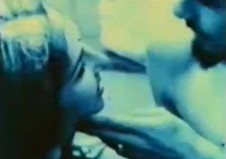
Fuses
Fuses
By Carolee Schneemann (1967, 16mm, color, 23 min.)
Filmed and edited by Schneemann; with herself, James Tenney and Kitch. "Pornography is an anti-emotional medium, in content and intent, and its lack of emotion renders it wholly ineffective for women. This absence of sensuality is so contrary to female eroticism that pornography becomes, in fact, anti-sexual. Schneemann's film, by contrast, is devastatingly erotic, transcending the surfaces of sex to communicate its true spirit, its meaning as an activity for herself and, quite accurately, women in general. Significantly, Schneemann conceives the film as shot through the eyes of her cat -- the impassive observer whose view of human sexuality is free of voyeurism and ignorant of morality. "In her attempt to reproduce the whole visual and tactile experience of lovemaking as a subjective phenomenon, Schneemann spent some three years marking on the film, baking it in the oven, even hanging it out the window during rainstorms on the off chance it might be struck by lightning. Much as human beings carry the physical traces of their experiences, so this film testifies to what it has been through and communicates the spirit of its maker. The red heat baked into the emulsion suffuses the film, a concrete emblem of erotic power." -- B. Ruby Rich, Chicago Art Institute
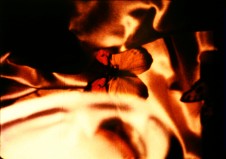
Third Eye Butterfly
Third Eye Butterfly
By Storm De Hirsch (1968, digital from 16mm dual projection, color, 10 min.)
Where is the light coming from? The flavor of the colors are succulent to the long vision in the soul. How can dust cover the arrows of light? How can darkness favor oblivion in the face of light? The variations of soul-touch exist in the auras of illumination. The Great Eye dominates. --S. D. H.
"The 70mm-like effect of THIRD EYE BUTTERFLY encourages the mind to work as a third eye by fusing the two side-by-side screens into a third meaning, just as Eisenstein caused the meanings of two juxtaposed shots to result in a third implied meaning." -Casey Charness, Columbia University
